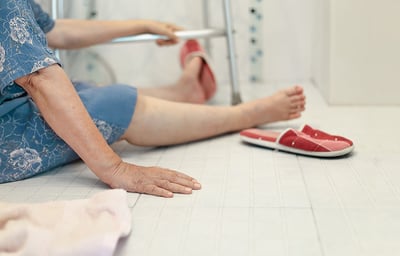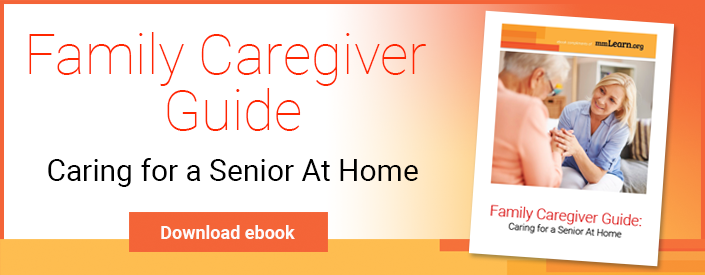 Falls are serious — and can be deadly for seniors.
Falls are serious — and can be deadly for seniors.
One in four older adults (36 million) reports a fall each year. That’s cause for concern.
So it’s no surprise that seniors and caregivers are seriously worried about falls.
The good news is that most falls are preventable, and there are measures people can take to increase home safety for seniors. And because falls are so common, it’s important to understand when you need to call an ambulance and how to safely help someone up after they fall.
Falls Are Common, and Dangerous
One in four older adults in the United States (36 million) reports a fall each year, and falls are the leading cause of injury and injury death for seniors 65 and older, according to the Centers for Disease Control (CDC). The CDC’s statistics on falls show that each year about 3 million older adults go to the emergency room after being injured in a fall.
One out of every five falls results in an injury, such as a head injury or a hip fracture. Older women are much more likely to fracture a hip in a fall.
Know the Risks
Some common reasons for falls include the effects of medications, muscle weakness, a lack of flexibility, vision issues, and environmental factors. The CDC's Stay Independent brochure includes a questionnaire that can help determine if someone is at a high risk for falling. Questions include the following:
- Have you fallen in the past year?
- Do you use a cane or walker to get around safely?
- Do you feel unsteady when you walk?
- Do you grab onto furniture at home to steady yourself or get up from a chair?
- Are you worried about falling?
- Do you need to rush to the bathroom?
- Have you lost feeling in your feet?
- Do you take any medication that makes you feel lightheaded?
- Do you feel sad or depressed?
People who answer yes to a number of these questions are at a higher risk for falling.
If you know someone is at risk, what can you do to prevent dangerous falls?
4 Tips for Preventing Falls
The CDC recommends four things you can do to prevent falls.
- Speak up. Talk to caregivers, health care providers, doctors, and pharmacists about fall prevention.
- Keep moving. Strong legs and good balance can help prevent falls. There are plenty of fall prevention classes out there, including some creative approaches like yoga and Ballroom Basics for Balance.
- Get an annual eye exam. Keeping eyeglass prescriptions up to date is important.
- Make your home fall safe. Remove objects and clutter that get in the way of safe passage.
Home Safety for Seniors
Together, caregivers and older adults can brainstorm ways to keep seniors safe. You can walk through the living space and look for all the places that might present a fall risk. It gives you an opportunity to talk, discuss, and solve the issues together.
The CDC has an easy-to-use checklist that helps you find and fix hazards in the home. It asks about clutter on stairs and floors, handrails and handles, high shelves, burned-out light bulbs, loose or uneven steps, slippery shower floors, and throw rugs.
It’s important to report every fall to a doctor. Every fall has a reason, and medical professionals need to know about them to prevent future falls.
There’s an emotional component to falls too. Seniors worry about losing independence or having to move if they get hurt in a fall.
Prevention Without Fear
Fear of falling is actually a fall risk. This mmLearn caregiver video talks about the worry that many older adults have that talking about falls will mean that someone will send them to a nursing home. It features Tracy Zerkle, lead trainer for A Matter of Balance: Managing Your Concerns About Falls.
Many people don’t report their falls to doctors or family members, and this increases the risk of falling in the future. “There are reasons that people fall,” says Zerkle, “But being old is not one of them. Falling down is not part of the normal aging process.”
The best way to talk about falls, she says, is to use nonjudgmental language and to say things like, “I am worried about you, and I don’t know what to do about it. How can I help?”
She suggests signing up to take a class together, or sharing walks. Staying active and engaged is one of the best ways to prevent falls.
Falls Still Happen
When falls happen, try to stay positive, and avoid making accusations. Follow up, but try not to focus every conversation on fall prevention or health. If you are nearby when a senior falls, here are 5 steps you can take to help your loved one to get up safely.
- Remain calm. Take slow, deep breaths, and encourage your loved one to do the same.
- Check for injuries. Falls can cause sprains and fractures in the hip, pelvis, spine, arm, hand, or ankle. Don’t move someone if they have a serious injury or have broken something. When in doubt, call 911.
- Take it slow. If you are certain the person isn’t seriously injured, proceed with caution, making sure to stop if they can’t continue.
- Help them get themselves up. Follow these best practices from the Public Health Agency of Canada (PHAC) for helping someone get up:
- Move a chair nearby.
- Help the person roll onto their side and then into a kneeling position with both hands on the chair.
- As they hold onto the chair, they should place the stronger leg on the floor and rise to a stand before turning and sitting on the chair.
- Provide guidance and support, but don’t physically lift them.
- Contact their health care provider.
Communication Helps Us Stand Tall
It’s important to talk about falls with family members and health care providers. For caregivers, approaching the topic of falls with sensitivity and compassion provides an opening to problem-solve and encourage healthy activity.
Understand that many seniors are worried about falls (for good reason), and this can create a vicious circle where they stop exercising or going out as much because of their fear of falling. Our online Family Caregiver Guide provides more tips on providing care for a loved one, including how to promote safety and mobility.
When everyone’s talking, fewer people are falling.

